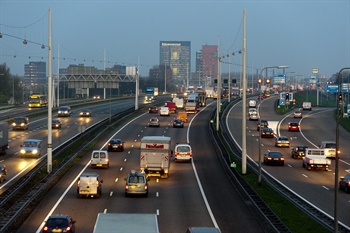Case study Rush-hour avoidance, Galecopper bridge
In order to reduce traffic disruption during refurbishment work, Rijkswaterstaat implemented rush-hour avoidance. It was a success: every day thousands of motorists opted to avoid the rush-hour traffic on this route. Many motorists continued to avoid the rush-hour on this route, even after the renovation work had been completed.
In 2014 and 2015, the Galecopper bridge (A12) in Utrecht was refurbished, resulting in a significant temporary reduction in road capacity. The Galecopper bridge is an important link in the regional motorway network around Utrecht. Therefore, during the two periods with the most anticipated traffic disruption, each of approximately four months, rush-hour avoidance was promoted.
The project
While the Galecopper bridge in Utrecht was being refurbished, motorists who actively avoided the bridge during the rush-hour were rewarded financially. The ‘Galecopper bridge rush-hour avoidance’ scheme paid participants each time they avoided the rush-hour; initially €4, and later €3. Motorists who frequently crossed Galecopper bridge in the rush-hour while baseline measurements were being taken received a letter asking them to participate in the reward programme. During both periods of operation (from September to December 2014 and from April to mid-September 2015 respectively) more than 50,000 road users were asked to participate.

The refurbishment of the Galecopper bridge was carried out following the widening of the A12 between Lunetten and Veenendaal. Rush-hour avoidance measures were implemented for both projects. The 2 projects were presented as 1 framework contract. A Minder Hinder [Less Disruption] plan was drawn up for the Galecopper bridge project, which included rush-hour avoidance. Other measures that contributed to reducing disruption included a communication campaign, referrals to P+R sites, and infrastructure adjustments. Smart phasing measures implemented by the contractor were also key to the success of disruption limitation.
Implementation
Baseline measurements were taken on the Galecopper bridge by means of vehicle registration, to determine who was eligible for the payments. In addition, data from the count was used to determine which rush-hour and in which direction rush-hour avoidance was desired. On that basis, it was decided to reward drivers who avoided the Galecopper bridge on working days. During the morning rush-hour this only applied to those heading towards Arnhem, in the evening rush-hour it applied in both directions.
Results
Of the 50,000 road users who were approached, more than a third ultimately participated in the programme. Further information about the effect of these projects can be found in the fact sheet Rush-hour avoidance projects. The aim in advance was to achieve a reduction of 1,400 rush-hour journeys per working day. The maximum recorded number of incidences of rush-hour avoidance was ultimately around 5,745 per working day. During the first 3 months after completion of the work, there was a drop in rush-hour avoidance of only 20%.
The explanation for the high incidence of rush-hour avoidance is probably twofold. On the one hand, people clearly felt the urgency to take action because of the severity of the work. On the other hand, the project did not take into account the fact that some participants could be driving in in the rush-hour twice and that the daily amount they could earn was therefore double.
Considerations for deployment elsewhere
Since July 2016, number plate recognition cameras may only be used in a rush-hour avoidance project in the event of major roadworks. Also, the period during which a participant may be rewarded financially is a maximum of 3 months (other forms of non-monetary reward may be longer). At present, the IMMA framework contract is the basis for the implementation of rush-hour avoidance measures (see beterbenutten.nl/imma for more information).
Vehicle registration data are privacy-sensitive and are the subject of much discussion. Rush-hour traffic avoidance projects must be reported to the Rijkswaterstaat privacy coordinator. The project manager is responsible for this.
Also consider traffic density and the period in which rush-hour avoidance should be implemented. Prior research can help to limit the incentives to what is necessary and to reduce project costs, without impacting on traffic disruption.
